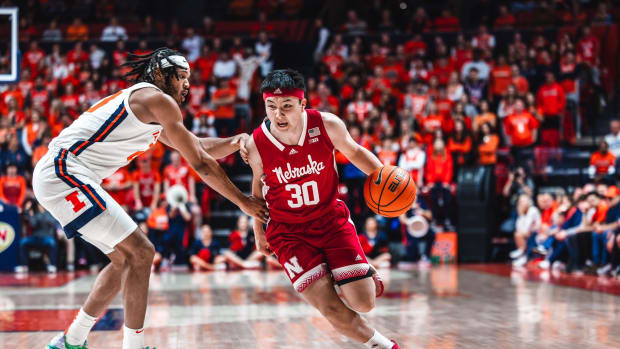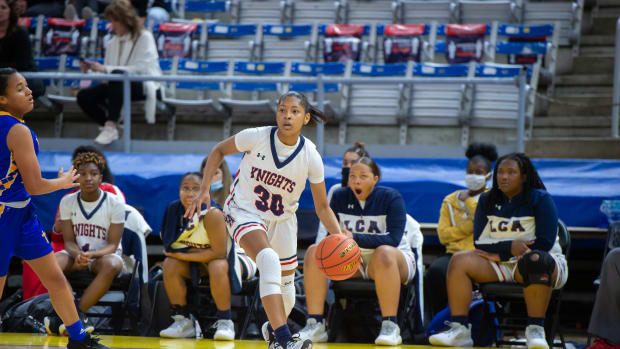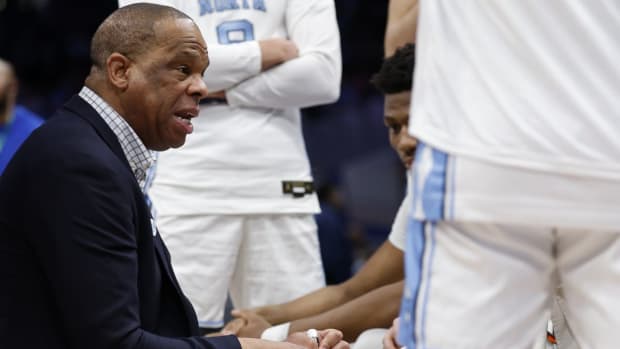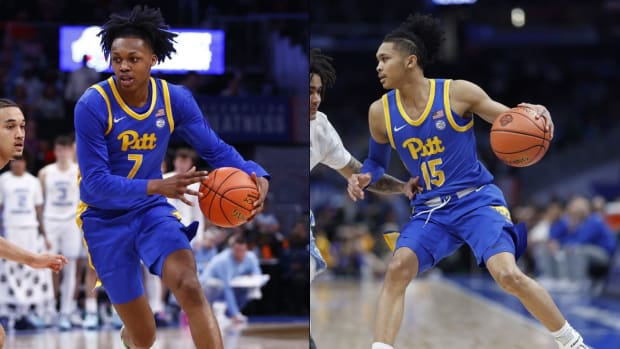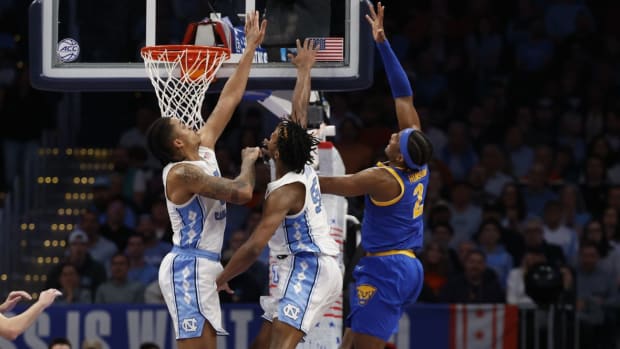Best Bets for 2019 NCAA Tournament's First-Round Games
The best time of the betting year is finally here: March Madness. Three Man Weave and I are back with our four favorite bets from Thursday and Friday's action, with one pick from each region. And without further ado, let's dive in.
East Region
LSU vs. Yale
3MW Pick: Yale +8
It’s impossible to talk about this matchup without addressing the elephant in the arena: Will Wade’s status on the LSU sideline. He’s currently suspended by the school for his failure to meet with the administration regarding his role in the pay-for-play scandal, preferring instead to let the investigation run its course. Without him, the Tigers dropped their opener in the SEC Tournament to a desperate Florida team, and stand-in boss Tony Benford got hit with a crucial technical late in the game. He’ll be tasked with preparing LSU for an incredibly well-coached Yale team down in Jacksonville. These Bulldogs include three senior starters who were a part of the 2016 squad that knocked off Baylor; of those three, Blake Reynolds and Trey Phills got on the court for both tournament games, matching the slight NCAA experience that LSU has (Kavell Bigby-Williams got bench minutes for Oregon in 2017).
Both teams in this matchup rely far more on their offense than their defense, and LSU’s 10th-ranked attack (per kenpom.com) exemplifies that dichotomy. The Tiger offense is at its best when assaulting the rim and dominating the offensive glass, as the massive and active frontline of Naz Reid, Bigby-Williams, Emmitt Williams and Darius Days lives to gobble up second-chance opportunities. The Tigers are fifth in the entire country in offensive rebounding rate, as even SEC frontlines struggled to keep the Tigers off the glass. Yale coach James Jones stresses the defensive glass, though, and Yale was 24th nationally in defensive rebounding rate, giving the Bulldogs a chance to hold their own against such an onslaught. Jordan Bruner, Paul Atkinson and Blake Reynolds form a frontcourt capable of competing with the big boys, much like Jones’s 2016 team that had Justin Sears, Brandon Sherrod and Sam Downey.
Outside of the glass, LSU’s offense revolves around the wizardry of its mini master: Tremont Waters. The 5’11" point guard is a deft distributor, and his vision in transition (plus the Tigers’ stable of athletes) has made LSU an incredibly potent threat in the open floor. Yale isn’t going to clamp down on tempo, but the ‘Dogs have been highly effective in transition on a points per possession basis.
Ordinarily, an Ivy team that plays almost exclusively man-to-man would be worrisome when stepping up a class in competition, but I don’t think this Yale roster will have serious issues at all. This isn’t your typical Ivy League team, folks. Yale has size, speed, and athleticism all over the court, with NBA prospect Miye Oni asserting himself on the wing and bigs like the bouncy Bruner and the 6’10", 220-pound Atkinson debunking many of the Ivy stereotypes. Of course, the cerebral Bulldogs are also tremendous passers and shooters, which helps explain why they have the 44th-ranked offense per KenPom’s adjusted offensive efficiency.
Also unlike many Ivy squads, Yale isn’t going to try to grind the game out with long possessions. Point guard Alex Copeland will frequently push in transition to probe for early scoring opportunities, and he put his deadly mid-range pull-up game on full display in the Ivy title game, torching the Crimson for 25 points (plus seven assists and zero turnovers). Waters will need to disrupt Copeland’s rhythm to derail the Yale attack, something he is plenty capable of doing when locked in defensively. Still, though, Yale has plenty of weapons, as Oni is a pure three-level scorer, Azar Swain is a human microwave off the bench, and Reynolds is a decent post-up option.
This one is likely to be a track meet, as both teams are content to see the opponent take quick shots so that they can get the ball back. With a savvy coach like Jones and some athletes of their own to match LSU, I think this one comes down to the wire, and eight is simply too high a spread. Give me Yale plus the points, and I’ll likely throw a sprinkle on the moneyline as well.
Midwest Region
Auburn vs. New Mexico State
3MW Pick: New Mexico State +7.5
Talk about two teams getting white-hot at the right time. Auburn just rattled off four in a row against the SEC’s finest, capped off by a 20-point demolition of Tennessee in Nashville. New Mexico State won its conference tournament in even more convincing fashion, blowing out Grand Canyon by 32 in the WAC final Saturday night in Las Vegas. This showdown between two hyper-athletic teams who live and die with the three-ball should deliver one of the more exciting opening-round tilts this weekend. In many ways, these two teams are mirror images of each other—they let it fly from deep, they feast on the offensive glass and they blanket opposing ball handlers with waves of defensive pressure.
For Auburn, the explosive offense is ignited by a pair of dynamos in Jared Harper and Bryce Brown, who will go toe-to-toe with two carbon copies of themselves in NMSU’s AJ Harris and Terrell Brown. While Chris Jans will rotate in as many as five different guards to the perimeter rotation, Harris and Brown are the bedrock of the Aggies’ backcourt. They are both stout on-ball defenders, but slowing down Harper and Brown requires a cohesive five-man effort defensively. Harper is especially deadly in pick-n-roll action and Bruce Pearl leans heavily on his game-breaking speed off the dribble to generate defensive breakdowns. Typically, he’ll bring any one of their versatile forwards well beyond the three-point line to set the initial screen, which gives Harper acres of space to maneuver and get a full head of steam going downhill toward the rim.
Here’s where an interesting dichotomy comes into play. From an eye-test perspective, the Aggies’ wings and forwards are tailor-made to defend quicker guards in space off pick-n-rolls, particularly Eli Chuha, Johnny McCants and Trevelin Queen. However, the data tells a slightly different story—per Synergy, New Mexico State grades out in the 36th percentile nationally in points per possession against PnRs, a slightly concerning figure against the high-octane Tigers offense.
Despite that minor red flag, everything else about this matchup sets up well for the Aggies. Auburn’s defense is inherently high-risk, high-reward with the steal-seeking guards and wings constantly in "gamble-mode." New Mexico State is one of the most unselfish teams in college basketball and should exploit the overextended Auburn defense with tic-tac-toe passing for a plethora of open looks. When Auburn struggled this year, it was because it let shooters run free on the perimeter, evidenced by their 327th-ranked defensive three-point attempt rate, per kenpom.com. Not staying tightly connected to shooters is a recipe for disaster against the Aggies, who had six different guys hit 20 or more threes this season.
What makes New Mexico State especially tough to cover is the inside-out balance, with those aforementioned guards and wings often revolving around Ivan Aurrecoechea in the post. The 6’10" Spanish import is a monster on the block and could terrorize the Tigers up front, particularly against lineups where Dion Wiley is on the bench. Eli Chuha will surely get his as well, but Aurrecoechea’s thick frame could really give the Auburn frontline fits.
The ultimate determining factor in this matchup is the coaching advantage I’m allotting to the Aggies. While Bruce Pearl should be commended for fine-tuning Auburn to be playing its best ball of the season at the right time, Chris Jans has delivered time and time again in big games when the stakes are highest. Just ask Kansas fans how ready he had the Aggies when they visited Lawrence earlier this season, coming just three points shy of beating the Jayhawks in Phog Allen. With many lessons learned from last year’s early tournament exit, expect Jans and his coaching staff to be well-prepared with an airtight game plan geared toward slowing down Auburn’s blistering-fast offense.
South Region
Kansas State vs. UC Irvine
Meyer's Pick: UC Irvine +5.5
With the Big West’s games often tipping so late at night, the public has missed out on getting to watch UC Irvine regularly. And it’s a shame, because the Anteaters are damn good. I love their depth (nine players average at least 16 minutes per game), the upperclassmen backcourt of Max Hazzard and Evan Leonard (who combined to score 23.6 PPG on the season) and the strong coaching job by Russell Turner.
But the top thing to know about the Anteaters: It’s really tough to score on this UC Irvine team. It has allowed opponents to shoot just 40.6% on two-point attempts (per KenPom), including 46.5% on attempts at the rim (per hoop-math.com). Both of those percentages are tops in the country. The Anteaters don’t give up many open looks from the perimeter either, registering the 15th-lowest opponent three-point attempt rate in the country (32.7%).
The Wildcats rank in the 20th percentile in terms of points per possession in half-court offense per Synergy (which you can expect a lot of with UC Irvine ranking 296th in adjusted tempo, and Kansas State at 342), and they could struggle even more if they don’t have star Dean Wade. The senior forward is the team’s second-leading scorer (12.9 PPG), best three-point shooter (41.8%) and best FT shooter (78.9%). Wade is also one of the better passers on the team (2.8 assists per game, third on KSU), as he’s able to set up his teammates with great looks if a defense is focusing too heavily on him.
Kansas State coach Bruce Weber told Yahoo! Sports that Wade will be evaluated on Monday by the team’s physician. But he’s still currently in a walking boot and has been getting treatment 3-to-4 times a day. Weber said, “I hope we have him,” but this doesn’t sound like a great sign for his availability in this one.
According to Hoops Lens, Kansas State has recorded 1.06 PPP with Wade on the floor this season. That number falls all the way down to 0.93 PPP when he’s not playing. The two major differences with Wade on and Wade off? Effective FG% (51.4% on, 47.1% off) and turnover rate (15.8% on, 19.6% off). He’s clearly an extremely important player for this group, and arguably the difference between an early-round exit and a dark-horse Elite Eight run (like last year).
Kansas State is fantastic defensively, as it ranks fourth nationally in adjusted defensive efficiency. But if there is a weakness on that side of the ball, it’s how Kansas State defends the interior. The Wildcats have allowed opponents to shoot 62.8% on attempts taken at the rim (tied for 275th in CBB). If you dig deeper, they rank in the 21st percentile in terms of PPP in all of college basketball defending post-ups, per Synergy. That’s really bad news against a UC Irvine team that runs post-ups 13.9% of the time, which is the ninth-highest frequency in the country.
But if Wade is out, his absence will be felt on the defensive end too. Kansas State allows 0.87 PPP with him in the game, compared to 0.99 with him not playing. His 6’10” frame would be crucial in this matchup, as Irvine rolls with two big men on the floor at the same time between 6’8” Tommy Rutherford, 6’9” Collin Welp (an incredibly unique freshman talent), 6’9” Elston Jones and 6’10” Jonathan Galloway (Irvine's all-time leader in rebounds). With Wade out, Kansas State has often had to go small with 6’9” Make Mawien the only other player taller than 6’5” who has been in for at least 20% of the team’s minutes this season. So whether it’s defending post-ups or keeping Irvine off the offensive glass (the Anteaters’ 33.6 OREB% ranks 32nd in CBB), the Wildcats are going to have major trouble against Irvine’s size.
The Anteaters also have the travel advantage since Friday’s game is taking place in San Jose. As I mentioned before, these two teams will both play at slow paces, and it’s tougher to cover a spread of 5.5 when there’s fewer possessions in the game. Kansas State’s poor FT shooting (66.4%, 314th in CBB) doesn’t help either. While I’m also a huge fan of Northeastern and Yale, UC Irvine is my favorite upset pick in the round of 64 of teams seeded No. 13 or higher. The 5.5 points is just an added bonus.
West Region
Marquette vs. Murray State
3MW Pick: Murray State +4.5
Marquette comes limping into the Tournament, losing five of its last six games down the stretch. The Eagles draw Murray State, the Ohio Valley champion that disposed of Belmont in the title game much to the delight of college basketball nation (two-bid OVC!!!). This game should be a high-octane, offensive funfest with Morant going toe-to-toe with All-American hopeful Markus Howard.
Marquette’s offense is defined by its shooting ability. The Eagles are first and foremost a jump shooting team; they rank just 306th in %FGA near the rim (hoop-math) and 67th in percentage of points scored from downtown (KenPom). They shoot it often and they shoot it well, cashing 39.3% of their three-point attempts this year, the ninth-best rate in the country. Four players on the Eagle roster—all starters—shoot over 40% from three: Howard (40.8%), Sam Hauser (40.1%), Joey Hauser (43.3%), and Sacar Anim (40.9%). When their offense is clicking, the ball movement is gorgeous to watch, pinging into the high post and out to open spot-up shooters. Howard is the catalyst to the attack, but the Hauser brothers are also capable creators in the half-court. Most offense is run through Howard via the pick-n-roll; Howard uses ball screens to knife into the lane or stop and pop from anywhere behind the three-point arc. On pick-n-roll possessions this season, Howard is scoring 0.95 PPP, 85th percentile in the country, and in isolation sets, Howard pours in a scorching 1.105 PPP, 92nd percentile in the country (both per Synergy).
When not bombing from deep, Marquette looks to score via transition and via basket attack. Both Howard and Joey Hauser make it a habit to get to the free-throw line, where the team connects at a 22nd-best 75.9%. Big men Theo John and Ed Morrow are solid rebounders, but they are rarely looked upon to put the ball through the basket.
The key for Murray State in this one will be to take away open three-point looks. In its nine losses this seasons, Marquette is shooting just 33.9% from downtown, and if you take out the Kansas game outlier (14/31), the Eagles are just 32.2%. Marquette is able to get to the foul line, especially Howard off the bounce, but it absolutely needs to shoot well from deep to win ball games. Take that production source away and you have an excellent shot at upending the Eagles. Very few teams in the country deny the three-point line better than the Racers. Murray State ranks fourth in the country in three-point percentage defense, holding opponents to just 28.5% from deep, and allows the 65th-fewest amount of 3PA in the country. Matt McMahon’s perimeter guard trio of Morant, Shaq Buchanan (OVC Defensive Player of the Year) and Tevin Brown makes life miserable for opposing shooters. They will 100% bother the 5’11” Howard with their length and quickness. Murray’s extended high pressure past the arc may not force the Eagles into a ton of turnovers, but it will make it extremely difficult to find clean looks.
Transition is the name of the game on Murray State’s offensive end of the floor. The Racers live up to their name with a focus on pushing the issue in the open floor and rank sixth in the country in eFG% in transition and 38th in FGA%. Morant is masterful pushing the ball downhill. All the hype that surrounds the 6’3” sophomore is completely justified—this guy is absolutely incredible. His creativity from a passing perspective and the way he’s able to fit into every crevice of the defense is simply awe-inspiring. He ranks third in the country in usage this season and is by far the national leader in assist rate. When not running, the Racers run their offense through Morant, who acts as the chief ball handler and playmaker. His decision-making is next level—he’s extremely unselfish and yet he takes the lion’s share of Murray’s shots in every game. He picks his spots on when to pass or shoot, and he’s almost always correct.
Marquette’s defense is MUCH improved this season from historical Steve Wojciechowski teams, ranking second in adjusted defensive efficiency in the Big East and 35th in the country (KenPom). The Eagles are stout defensively thanks to their anchor in the paint, Theo John. His shot-blocking prowess acts as a safety blanket for Eagle guards and wings, allowing them to shade the three-point line a little more aggressively knowing the big man has their back in the middle.
The Morant matchup is obviously the focus for Marquette on this end. Anim likely starts on Morant, using his 6’5” frame to his advantage in an effort to hinder the superstar enough to slow him down. Howard has been much improved this year on defense, but Morant likely torches him if the pair match up. Role player Joseph Chartouny has played limited minutes recently, but the former Fordham Ram is arguably the best defender on the team, so Wojo may opt to use him a bit more in this one. Morant is unlike any player in the country, but taking a look at what star guards have done against the Eagles this season doesn’t inspire confidence in the No. 5-seed favorite: Indiana’s Romeo Langford put up 22 PTS on 8/15 shooting, St. John’s Shamorie Ponds averaged 27 PPG and shot 17/34 in two contests, and Seton Hall’s Myles Powell averaged 28 PPG and shot 18/41 in two games.
Morant should be able to have his way with Marquette defenders out on the perimeter and will have plenty of opportunities to score on the run—the Eagles rank just 306th in the nation in limiting transition opportunities.
As is the case in most Power 6/mid-major matchups, size could prove to be a determining factor. Yes, Marquette is primarily a jump shooting team, but the Eagles aren’t robots—if Theo John is sitting on the block against an inferior defender, they will get him the rock. The offensive glass could be a bountiful source of production for the Eagles if Murray extends to far on shooters and leaves the sizable Eagles free to run to the rim.
The line is low, but this matchup favors the Racers. Murray State takes away what Marquette wants to do on offense, while the Eagles won’t necessarily be able to do the same on the other end. I like the Racers to cover and pull the upset in a high-scoring affair.
